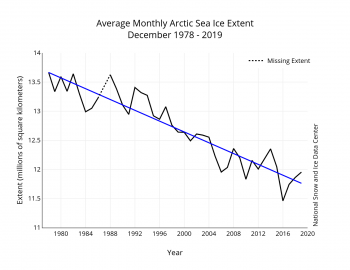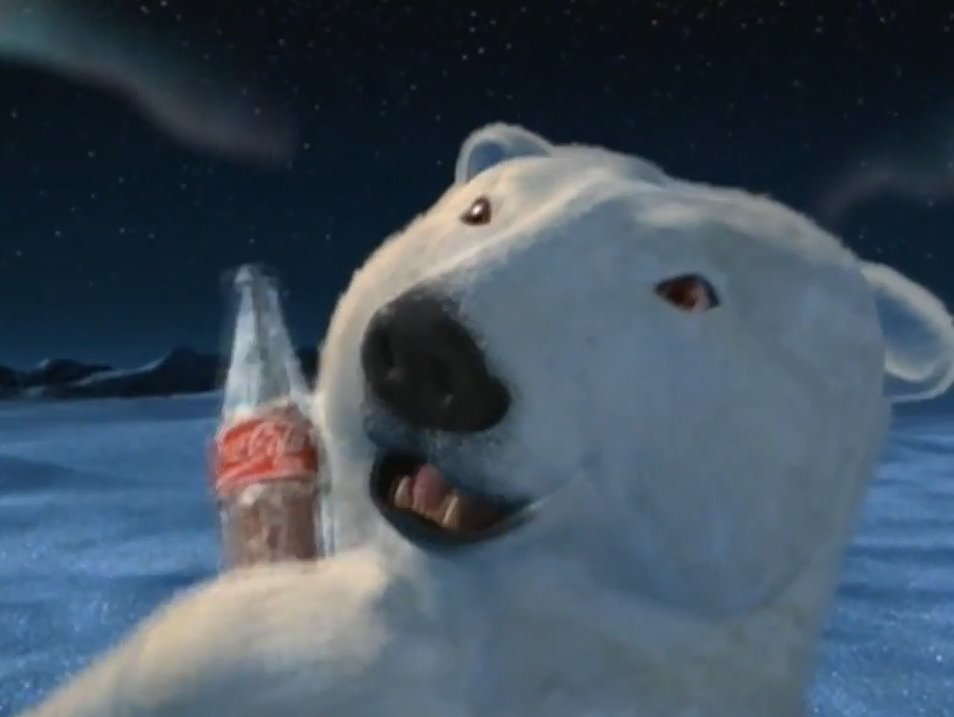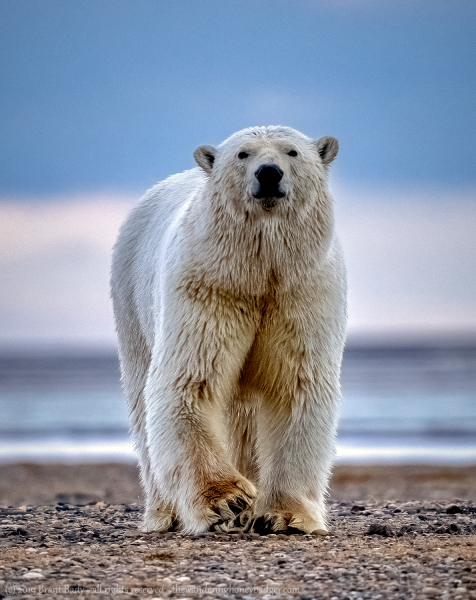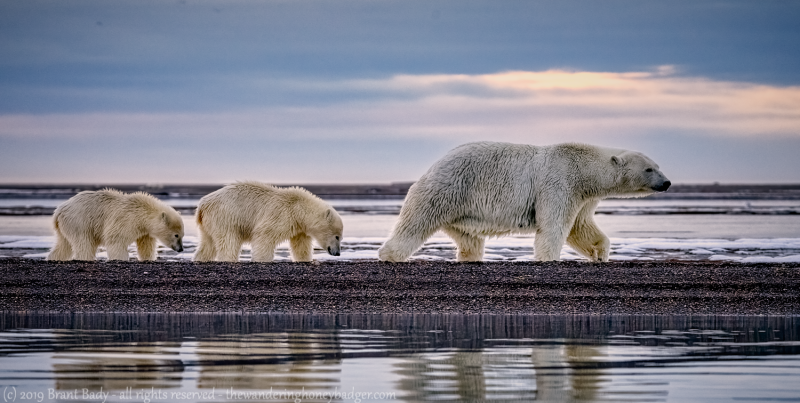 The Polar Bear Commute – inbound and outbound to the local whale bone pile.
The Polar Bear Commute – inbound and outbound to the local whale bone pile.
What I learned about polar bears, during and after a recent visit to the Beaufort Sea. This narrative, starting below, will be an eight part series (a new part being posted daily until Feb 27th which is International Polar Bear Day) and is meant to accompany my Polar Bear Image Gallery that has the top fifty images I selected from more than 12,000 frames, as well as short incredibly cute video.
Are Polar Bears the Ultimate Symbol of Twenty-First Century Post-truth Environment?
In recent years, a few striking images of skinny starving polar bears have become the face of climate change in the media around the world. Climate deniers are often quick decry such images saying there is no proof that the bear was actually skinny due to global warming, and that the number of polar bears appears to be increasing. In their minds there is no case for impending extinction (not for bears, nor humans). It is in fact a full-blown conspiracy theory for many of them, and this polarization of opinion has led to much rancour.
It should be indisputable that Arctic sea ice has greatly diminished in recent decades, as the science is quite clear.

Source: National Snow and Ice Data Center
Yet misinformation still abounds. Alternative facts are oft cited by the Alex Joneses of the world in which they claim the extent of Arctic Ice has in recent years been identical to that as first measured 1979. That particular fiction is ridiculous, as it has been discounted by the very source cited from those pushing the climate denial narrative.
Similarly, while polar bear populations may have increased in one locale according to the latest IUCN Red List (M’Clintock Channel), they have decreased in three other sub-populations (Baffin Bay, Kane Basin, and Southern Beaufort Sea), and the others either appear to be holding at the moment, or there is insufficient data. Increases in population count are predominantly due to the fact that humans are not hunting and killing them in the same numbers as in the past. Realistically, not every polar bear has to be as anorexic as a runway model for there still to be serious issues regarding the impact of climate change on the bears as an overall population.
As one credible polar bear expert says, it is essentially a matter of habitat loss.
Polar bears inhabit a specialized niche in the Arctic environment. They hunt seals out on the ice as their main source of food, with adult bears feast almost exclusively on the skin and blubber. With reduced sea ice, their hunting patterns and efficiency is impaired, as they have to swim or walk further to get to their hunting grounds, and their normal diet disrupted. As most people are aware, since apex predators sit at the top of the food chain, they tend to accumulate high levels toxic chemicals from the environment if they are present. Apparently now some polar bear cubs have levels 1000 times the acceptable amount for people.
Not only are the bears very powerful apex predators, they are also resourceful. In some locations, polar bear populations are already altering their behaviour. The bears now spend an extra month of time onshore waiting for the ice to form in the fall freeze up on the Beaufort Sea.
In other areas around the arctic, the bears are invading communities, “choosing” to snack on garbage instead of nearby accessible bearded or ringed seals. This should surprise no one, as “bears will be bears”, regardless of human sentiment or spin. The garbage discarded by people becomes fast/junk food for polar bears, with the same kind of unhealthy results that junk food has on humans (notwithstanding iconic and endearing historical advertising campaigns).
 Coca-Cola Polar Bears 1993 Commercial “Northern Lights”
Coca-Cola Polar Bears 1993 Commercial “Northern Lights”
This becomes further exacerbated by the fact that the polar bears who snack on garbage wind up eating a lot of plastic in the process.
As their environment and diet changes, the size and longevity of polar bears will impacted, just as any reasonable person would expect. Those changes will, over time, cumulatively affect the overall health and extent of the wild polar bear population. This is why credible scientific organizations consider polar bears to be at risk. Since 2008 they have been formally listed as a threatened species, and current estimates suggest that they are likely to go extinct before the end of the 21st century.
The Search for the Best Polar Bear Hangout
In my case, I wasn’t looking for skinny polar bears, I wanted to see, photograph, and document the status of healthy animals, and observe their behaviours. Confession: I used to work for an Archives, so I am quite aware of the important role photography can be in documenting how things were at a certain point in time. My other motivation is to share those images more broadly, to show people the magnificence and beauty of these animals, and to give some consideration as to what we may be losing if we continue down our current path. In my mind we should be doing everything we can to ensure their long-term survival!
While doing my advance research, I uncovered a few locations around the world where photographing polar bears might be possible.
Churchill Manitoba is one notable place, and since I was born in that province it could have given me an excuse to retrace some childhood locales, and see some relatives as well, but the issue with Churchill is that viewing is normally high above the ground in Tundra buggies, looking down at the bears, so photographically the angles are much less dramatic.
Another option is Svalbard, an island in the Barents Sea, north of Norway. A trip here would be similar to go to Antarctica, in that it would have to be on an expedition ship. I also had discovered that the light here can be very nice, a pinky/blue hue at certain times. Unfortunately, it seemed evident that it was going to be very expensive, and the odds of great polar bear sightings were going to be too limited for my purposes.
However, my research uncovered a place in Alaska, above the Arctic Circle on the Beaufort Sea. It had three significant advantages: 1) the polar bears were fairly easy to sight as they tend to congregate in this area to wait for the sea ice to form and reach shore so that they get out and hunt seals 2) the local village helps out by leaving out some snacks for the bears while they wait, i.e. the village has an annual Bowhead whale hunt for food, and the left over whale carcasses are piled up on the beach in August, and 3) the viewing is done from small boats so the angle is dramatically low and one can get reasonably close with a long telephoto lens.

Intimidation
Mid October was apparently the best time for viewing at this place, just before the freeze up when the bears would take off onto the arctic ice, and hopefully the possibility of having some white snow on the ground, but it had to be planned and booked many months in advance.
Wildlife photographers generally try not to be too specific about locations, so as not to destroy the area due to an influx of tourists, and of course I respect and share that concern. Anyone, who is destined to go there, will easily be able to figure out the exact place, so I will leave it at that rather than naming the specific location.

Having seen and photographed a variety of apex predators around the world, and become somewhat jaded in that regard, it turned out to be one of the most interesting expeditions / trips that I have done. I would also note that this trip for polar bears was one of the most expensive “safaris” I have ever taken around the world – more expensive on a daily basis than even a trip to Antarctica.
Side note: It would be the height of hypocrisy to proclaim concern for conservation and climate change, while merrily flying around the world spewing carbon, so in recent years I have moved to be nearly if not 100% carbon neutral by offsetting my own personal carbon footprint, including both traveling and domestic living. I do so by funding reforestation projects that are certified to provide specific carbon offsets.
However, you can have a bit of my polar bear experience in your own home, the special “Stinky Toes In My Nose” towel in my Bed and Bath items featuring Polar Bears, or other wall art.
And most importantly, if you are falling in love with Polar Bears (like I have), please do help support their ongoing survival and give a donation to Polar Bears International.
Check back daily for additional posts in this eight part series, leading up to International Polar Bear Day on Feb 27th!
